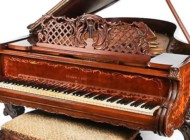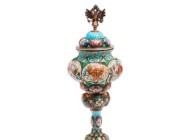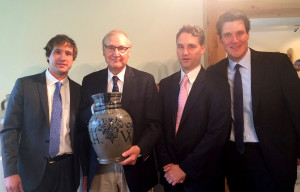
Crocker Farm is a family business. Patriarch Tony Zipp stands with his sons (from left) Mark, Luke and Brandt. Asked to hold up a key piece in this photo taken during preview before the sale started, Tony was prescient in choosing the Ezekiel Wood pitcher that led the auction and set a record price at $143,750.
Review and Onsite Photos by Andrea Valluzzo, Catalog Photos Courtesy Crocker Farm
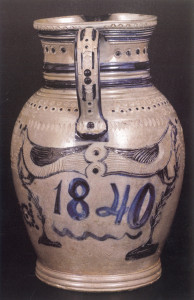
The top lot of the sale was the Ezekiel Wood 3-gallon stoneware pitcher that set an auction record for Kentucky stoneware at $143,750. The Maysville, Ky., piece was stamped “EH Wood” and dated 1840. This piece was made when Wood was 21, the standard age when indentured apprenticeships end. The craftsmanship of the piece as well as its large size (easy for passersby to see it in a shop window) and the lavish decoration suggests Wood made this piece to prove his skills as he set up his own business.
SPARKS, MD. — If there is one thing you can say with certainty about auctions, it is that nothing is certain. Prices and markets can be high one month and down the next, though specialty sales are a bit more insulated than general antiques and have continued performing well. The second of Crocker Farm’s thrice-a-year antique American stoneware and redware pottery auctions this year took place July 16 and saw some items struggle to meet estimate, while many other pieces handily soared past estimates. Overall the sale was a success and saw strong prices across the board, including a new auction record for Kentucky stoneware.
Early in the morning before the auction began at 10 am, about ten stoneware dealers were set up for a swap meet in the parking lot in front of the Gorsuch Barn, where Crocker Farm conducts its auctions. Of note, the barn is 175 years old, so the Zipps got not one, but two, large sheet cakes each decorated with a historic photo and a current photo of the barn. Attendees got to enjoy the cake later in the day, along with a generous spread set out for lunch.
Ruth Rodgers, New Holland, Penn., trading as School House Barn Antiques, offered a nice J. Hamilton & Co. stoneware jar, in the swap meet. To claim a parking space, she woke at 4 am. As this was her first time doing the meet, she only brought a few items, including a large J Hamilton & Co., Greensboro, Penn., piece but plans to bring more items next time. “You get to see a lot of your customers and the dealers you know,” she said.
Across the lot from Ruth, Geoffrey Bean was set up. A collector for more than 30 years, he was offering some pieces from his own collection but had a seat reserved with his name in the back of the auction gallery and planned to acquire a few pieces. “There’s always something I’m looking at in the auction. One hand feeds another.”
Inside the barn, several dozen people flitted about, checking out the items displayed on pedestals, on shelves and behind glass cases, enjoying some coffee and donuts and chatting with other collectors. While auctions are inherently competitive, the mood here was jovial and reminiscent of a family reunion with people chatting away and catching up on news since the last time they had seen each other.
From dealers to private collectors to the curious, auctions here typically bring out droves of attendees. Sue Grier of northeastern Maryland did not count on being able to buy any pieces herself but as the great-granddaughter of Chester County potter Ralph K. Grier, she had to come to see firsthand a Grier-attributed piece she had not seen before: a 2-gallon stoneware jar with a cobalt rooster and floral decorations, circa 1875. “Figural-decorated stoneware from eastern Pennsylvania is considered very rare. This jar is one of only two examples of Grier stoneware with figural decoration that we have seen,” according to the auction catalog. Estimated at $1/1,500, the jar more than doubled high estimate to bring $3,450.
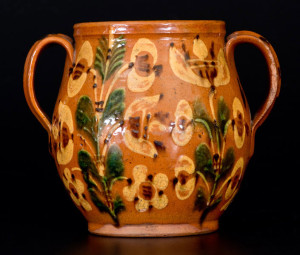
Leading redware offerings in the sale was this 1810 Bucks County, Penn., jar ($6/10,000) with extravagant slip floral decoration at $57,500.
“It’s just fun to come and see what’s here,” she said, noting she follows the auction house on Facebook, which is how she knew several pieces of Grier stoneware were in this sale. A cake crock and several other jars with only foliate brushwork brought a few hundred dollars each.
While the demographics at antiques shows often skew older, it was heartening to see a few young collectors in the audience here. One couple in attendance, who looked to be in their 30s, were Philip and Corbett Toussaint of South Carolina, who are regulars here. The couple is particularly interested in South Carolina stoneware, especially the Edgefield District, so it came as no surprise that they bid on — and acquired — the 4-gallon, alkaline-glazed stoneware jar inscribed “Dave / Jan 13-1862” at $40,250.
“It combines history and decorative art in a three-dimensional form,” Corbett Toussaint told Antiques and The Arts Weekly of this piece during preview, adding that when one studies a piece, one looks at what was going on in the world at the time. The jar was produced during the Civil War and is one of only a few known pieces from 1862 by the enslaved potter. It is also notable as the light-colored glaze was unusual when most of Dave’s work during this time used a darker coating. As one of his later pieces, Dave’s inscription is quite bold in keeping with a trend noted by Goldberg & Witkowski that his signatures grew larger over the years.
Philip Toussaint is a native South Carolinian and when the couple moved back there, Corbett said she took a pottery class. While fun, she admitted she was not a skilled potter but it led her to become a collector. Her instructor brought in a book one day that changed her life: Cinda Baldwin’s groundbreaking Great and Noble Jar: Traditional Stoneware of South Carolina. “We got really interested learning about it and we’re now hooked.”
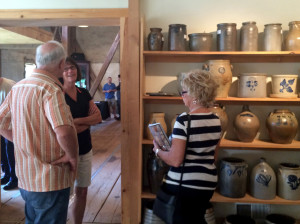
People travel from all over to attend these auctions and preview time is spent in equal measures of checking out items as well as socializing.
Kicking off the auction was lot 1, a rare and important stoneware flowerpot attributed to William Morgan, Baltimore, Md., circa 1820–25. The flowerpot has crisp incising and lavish cobalt decoration featuring birds perched on stems of a flowering plant. Estimated at $40/60,000, a phone bidder battled it out with a buyer standing near the back of the gallery for this piece and won it for $63,250.
About an hour and half later, the top lot of the sale crossed the block. An Ezekiel Wood 3-gallon stoneware pitcher set a new auction record for Kentucky stoneware when it attained $143,750. The Maysville, Ky., piece, stamped “EH Wood” and dated 1840, bore lavish decoration.
All prices reported include the buyer’s premium.
Crocker Farm’s next auction will be in October. For information, www.crockerfarm.com or 410-472-2016.
[slideshow_deploy id=’1000271781′]

